
We are celebrating 15 years — and counting — of stories that are deeply researched and deeply felt, that build a historical record of what the city has been.
We are celebrating 15 years — and counting — of stories that are deeply researched and deeply felt, that build a historical record of what the city has been.
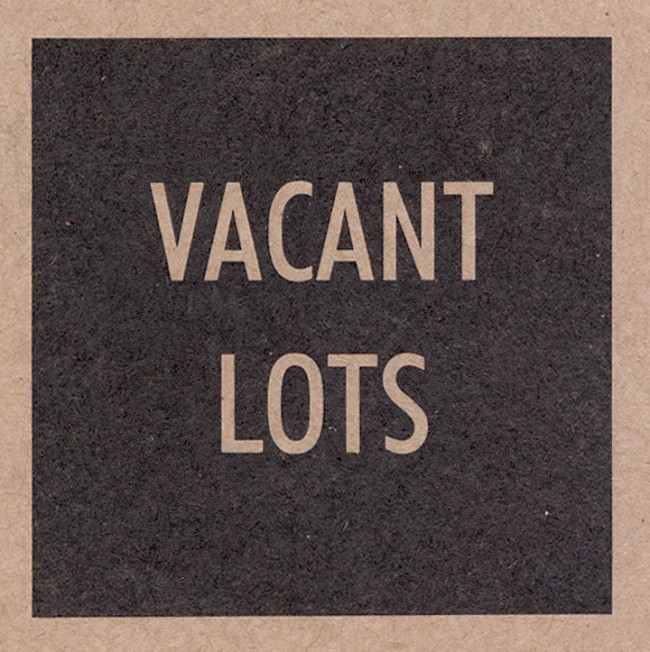 25 years ago, New York City was a very different place. In 1987, a 40-year trend of population decline was only just starting to reverse itself, and the legacy of disinvestment was still evident in challenged neighborhoods in each of the boroughs. Little more than a decade had passed since the nadir of the city’s economic collapse, during which the crisis of abandonment coupled with a series of policy decisions forced the City of New York into the uncomfortable position of owning and operating thousands of properties, including abandoned buildings, occupied or semi-occupied buildings, and vacant lots.
25 years ago, New York City was a very different place. In 1987, a 40-year trend of population decline was only just starting to reverse itself, and the legacy of disinvestment was still evident in challenged neighborhoods in each of the boroughs. Little more than a decade had passed since the nadir of the city’s economic collapse, during which the crisis of abandonment coupled with a series of policy decisions forced the City of New York into the uncomfortable position of owning and operating thousands of properties, including abandoned buildings, occupied or semi-occupied buildings, and vacant lots.
Such a large inventory of City-owned properties led to necessary creativity on the part of policymakers about how best to meet widespread housing need. But official efforts focused, understandably, on those properties that would either yield the most units or be the least costly to bring to market. Therefore, small, scattered parcels in low- or medium-rise neighborhoods received less attention, their development prospects for affordable housing initially considered to be economically unfeasible. In 1987, to investigate the potential of this complex area of the City’s property portfolio, the Architectural League and the New York City Department of Housing Preservation and Development (HPD) partnered on a landmark design study. Vacant Lots invited architects to propose prototypical designs for such lots, thus helping to make the case for the viability of small-scale infill housing as a strategy to develop affordable homes across the city.
The project began with the design study and culminated in an influential exhibition and book. The essays and designs that emerged from this project certainly mark a particular moment in a series of overlapping histories: of New York City, of architecture in the public interest, of collaboration between cultural organizations and government agencies, of the relationship between design and public policy. And a lot has changed since that moment in each of those registers. But the work that emerged from Vacant Lots resonates with our contemporary moment in powerful ways. To recognize that resonance, in addition to releasing selections from the original project on archleague.org, Urban Omnibus revisits the original study sites in the pages that follow, to see what happened to those lots and in those neighborhoods over the past 25 years. Next week, we will conclude the 25th anniversary of this project with reflections from some of the original participants, many of whom have gone on to explore issues of urban housing environments in wide-ranging careers in architecture, finance, and scholarship.
Flexibility is not invoked often enough as an architectural principle.The study identified ten sites owned by the City — three each in the Bronx, Brooklyn, and Queens, and one in Manhattan — that “could be developed by small-scale contractors or community-based development groups [and] could be the basis of a new strategy for reweaving the fabric of neighborhoods.” The selection of these particular sites reflected opportunities for “inventive solutions in apartment design, in the combination of apartment types, and in the relationship of the building to the site and adjoining buildings.” Calling out that relationship to the street, the block and the neighborhood – that potential for “reweaving the fabric” torn up by disinvestment if not malign neglect – foregrounded the study’s rootedness in context, in existing conditions, in the specificity of New York’s built environment and diversity of its housing stock. But the context to which the study sought to respond was not exclusively physical. The social composition of these neighborhoods suggested a fresh look at the program requirements for the types of households in need of housing support. Changing demographics, emerging challenges in public health, and a shifting labor market meant that the types of housing traditionally supplied or subsidized by government programs were not necessarily the most appropriate types to meet the demands of the day. Therefore, architects participating in the study designed housing units for singles and single-parent households, temporary residences organized around communal or shared services, live / work complexes, supportive environments for the homeless and individuals living with HIV / AIDS. Each of the proposals demonstrates both a deep familiarity with the City’s guidelines for affordable housing as well as a willingness to reconsider building standards. More expansively, according to the analysis of Deborah Gans, “each project carries in its form the expression of its architect’s imagined city,” reflecting the design principles that inform, for each participating architect, bespoke and site-specific approaches while simultaneously hinting at normative philosophies of urbanism.
On the pages that follow, we see what was built instead: for the most part, attached or detached two-family dwellings, a couple standard, multi-family apartment buildings (including one low-income housing development), and even a lot that remains vacant to this day. In most cases, the new buildings built since 1987 suggest — in their appearance, materials, and site orientation — an expediency of design and construction that contrasts with the older brownstones, tenements, or housing projects adjacent to them.
But, in revisiting these sites, we also see another story of change, told in the vastly reduced percentage of vacant land in each site’s surrounding neighborhood. Over the past 25 years, New York City’s population growth has greatly intensified the development pressure on sites of all kinds: neighborhoods where a market for a cheap, single-family home was once unthinkable are now having trouble meeting demand for multi-family apartment buildings. The City has disposed of most of the properties seized in-rem. The crisis of abandonment in a depressed real estate market has given way to a crisis of foreclosure following an inflated real estate market. Throughout, providing homes affordable to all New Yorkers has remained a consistent challenge. And the housing needs of those New Yorkers have continued to evolve.
Over the past two years, the League collaborated on a new design study initiated by the Citizens Housing and Planning Council (CHPC), that deals explicitly with the mismatch between those evolving needs and a static regulatory framework for housing in New York City. That mismatch constricts the ability of designers and developers to introduce innovative housing types – those more suited to contemporary household demographics – into the real estate market. For Making Room, the new study, CHPC and the League invited teams of designers to design prototypical housing models for New Yorkers whose needs are not currently being met due, in part, to outdated and prohibitive codes and regulations: single adults who want to live alone, joint and multi-generational families who want to live together, and groups of unrelated single adults who want to live alongside each other, sharing resources and maintaining privacy where possible. Some of the designs proposed in this design study will be presented at an exhibition at the Museum of the City of New York that opens on January 24th.
Making Room, according to CHPC executive director Jerliyn Perine, began in response to the projection of a million more people living in New York by 2030. The focus on codes and standards emerged from a desire to learn “how a million more people would fit into our housing stock.” And certainly, some of the answer will require smaller units, provided they are safe and located in neighborhoods where the infrastructure can accommodate higher densities. Official recognition of this strategy of increasing the supply of available units has come in the form of the adaptNYC initiative, for which HPD has opened a design and development competition for the design of “micro-units” in a City-owned building in east Midtown Manhattan. This initiative is part of a wave of such developments in dense cities like Tokyo, San Francisco, and even Seattle, which are changing zoning codes to increase housing supply (and population density) without necessarily increasing the size or height of buildings.
But shrinking the minimum amount of space legal for a dwelling unit is not the only policy change needed to address the challenge of affordable housing in New York City. In her illuminating essay “New York Housing” for Vacant Lots (the 1989 book that catalogues the design study), historian Deborah Gardner traces the origins of the types of housing that surround each of the design study lots: row houses, tenements, and one or two-family frame houses. She explains how “the notion that low-income housing could only be improved by expanding the size of the basic land unit [caught] on as the [housing] reform movement gathered its forces.” And she also argues for forms of housing that offer “the most flexibility and the best chance of rebuilding communities and neighborhoods.” Flexibility is not invoked often enough as an architectural principle. But it lies at the heart of how to answer questions embedded within projects like Vacant Lots, Making Room or adaptNYC: how do we get more capacity out of what we already have? First, look closely at past; then, look closely at how people are making do with what already exists; and finally, think big about how to turn those two orders of observation and analysis into design proposals for a future that expects — that welcomes — the fact that households, neighborhoods, populations, and cities all change over time. –C.S
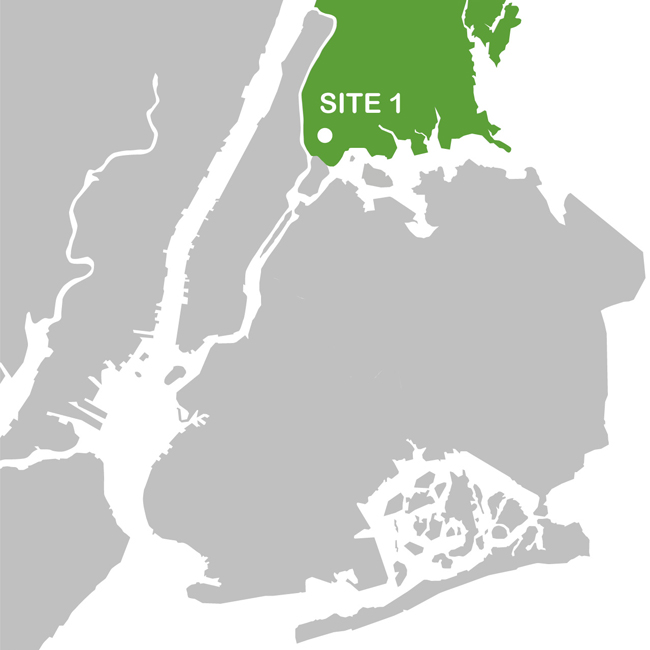 SITE 1
SITE 1
446 & 448 East 144th Street
and 447 & 449 East 143rd Street
Mott Haven, The Bronx
Site 1 was in the South Bronx, in Community District 1, which includes the neighborhoods of Melrose, Mott Haven, and Port Morris. Site 1 stretched through the block from 143rd to 144th Streets, between Willis and Brook Avenues. The site measured 33′ x 200′ and was zoned R6. In 1985, 33% of the land in the district was classified as vacant land. Despite the large population losses in the district between the late 1960s and 1980s, newly constructed housing was needed to supplement what could be provided by renovating existing buildings.
Many Vacant Lots participants chose to address the social needs of particular underserved or marginalized communities in their designs, ranging from single parent families to elderly individuals to people recovering from addiction. The pursuit of architecture as social activism is perhaps best illustrated in Gustavo Bonevardi and Lee Ledbetter‘s proposal, “Homes for People with AIDS.” At a time when, damningly, the President of the United States had only recently said the word “AIDS” in public for the first time, Bonevardi and Ledbetter’s attention to the challenges of providing affordable and supportive housing to this ostracized and fast-growing population demonstrates architecture’s potential to provide not just shelter, but dignity, health, and security to those who need it most. Bonevardi and Ledbetter’s original project statement, as published in the 1989 book documenting the Vacant Lots study, follows:
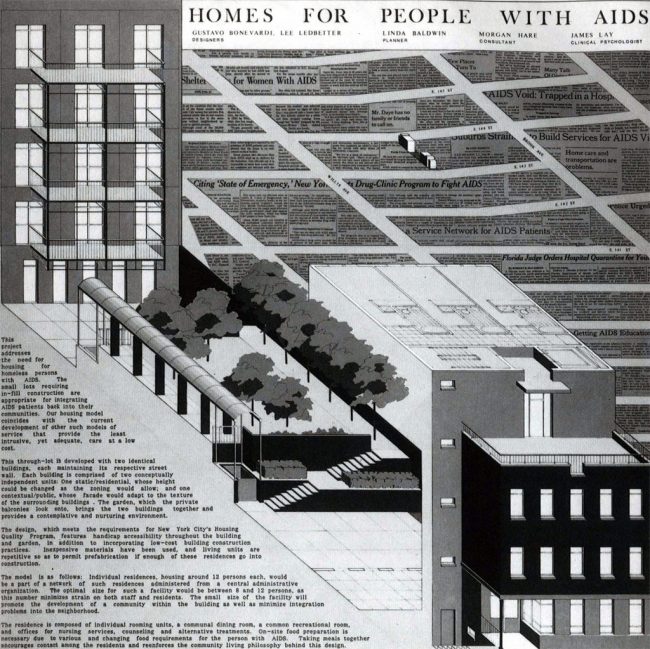
446 & 448 East 144th Street, 447 & 449 East 143rd Street, Bronx | Vacant Lots design study response by Gustavo Bonevardi and Lee Ledbetter
Gustavo Bonevardi and Lee Ledbetter, designers; Linda Baldwin, planner; Morgan Hare, consultant; James Lay, clinical psychologist
Homes for People with AIDS Inefficiencies in the housing market have resulted in thousands of homeless in our city. Added to this large group is the ever-growing number of people with AIDS. Medicare costs continue to grow as hundreds of persons with AIDS languish in hospitals throughout the city. Many of these individuals are often healthy enough to leave the hospital, yet they have no place to go. This situation requires new and creative approaches to their housing needs.
The small vacant lots requiring infill construction are ideally suited for the kind of housing these people need. Other low-income housing developments, such as the large public housing projects spread throughout the city’s poorer neighborhoods, have found economies of scale to be essential in determining their success. The type of housing which would be required to house the homeless persons with AIDS cannot, however, be based on the premise of economies of scale. Instead, smaller projects are essential in order to minimize the effects on the neighborhoods where this housing would be built.
The higher costs inherent in this type of construction-which requires handicap accessibility as well as private bathrooms to protect the health of the residents-must be compared to the costs associated with using our hospitals for long-term living arrangements. All residents would be eligible for government assistance (rent supplements, disability payments, Medicaid, etc.) and, because many are already being provided with social and medical services on an outpatient basis, these costs would not increase.
Our project addresses the viability of small, low cost housing developments for homeless people with AIDS. However, the proposed design is not limited in its use to this population alone. The provision of offices for professional services and the communal dining facility make this building suitable for other homeless sub-populations with special needs, such as the mentally and physically disabled, who are not able to live unsupervised in traditional housing arrangements.

446 & 448 East 144th Street (left) & 447 & 449 East 143rd Street (right), Bronx, 2013 | Photos: Daniel Rojo
The City sold the properties in 1987 and 1989. Today, a six-story residential building has been built on 144th Street, while the site on 143rd Street is utilized only to park cars. Vacant land in Community District 1 fell from 33% in 1985 to 3.8% in 2011.
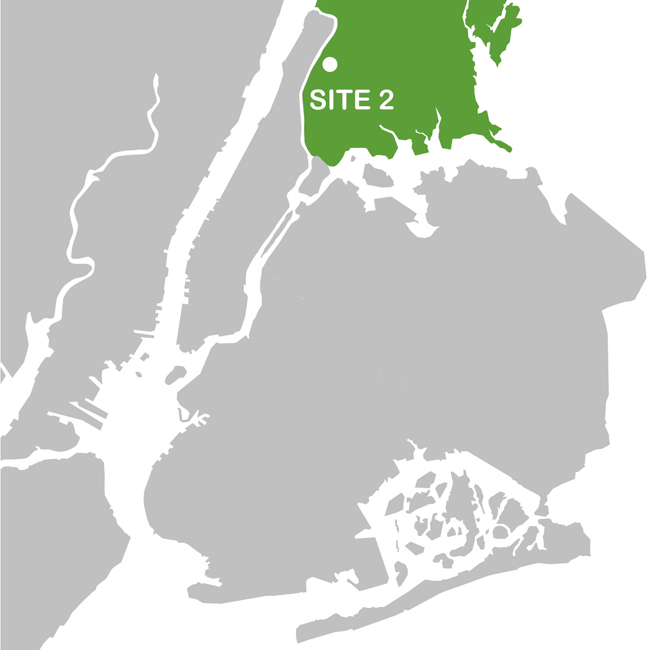 SITE 2
SITE 2
1000 Faile Street
Morrisania, The Bronx
Site 2, at the corner of Aldus and Faile Streets, was in Community District 2 in the southeastern Bronx. The site measured 50′ x 100’ and was zoned R7 -1. In 1985, 56% of the population of the district received some form of public assistance, a very high proportion compared to the citywide average. Yet in the 1980s, sales prices for vacant land and buildings in the area had begun to rise. Almost 30% of the land in the district was vacant at the time of the Vacant Lots study.
In their design for Site 2, the team from Voorsanger and Mills Associates focused on the dearth of housing options for individuals and groups living outside traditional notions of the nuclear family, and the obstacles facing cash-poor tenants who hope to work towards ownership. By exploring the benefits of starter units, shared spaces and flexible uses — the potential of which is being considered again today, as evidenced by many of the design proposals from the Making Room design study and the City’s AdaptNYC micro-unit housing pilot project — this proposal demands housing stock that reflects and serves the heterogeneity and ever-changing needs of New York City’s population. Voorsanger and Mills Associates’ original project statement, as published in the 1989 book documenting the Vacant Lots study, follows:
Voorsanger and Mills Associates
Bartholomew Voorsanger, Partner in charge; Kevin Gordon, Associate; Randall Cude, Anne Elizabeth Perl, Enrique Colmenares, Satoshi Ohashi, Medea Eder, Eileen Delgado
The vacant lot addresses the ineffectiveness of all builders of housing in realistically envisioning affordable housing in urban America. For individuals and families wishing to own their own housing facilities, two major stumbling blocks are tax law discrimination and a stubborn insistence to perpetuate the stereotypical apartment/house for the “nuclear family.” The 1988 Omnibus tax law disenfranchises cash-poor families by allowing only two major deductions for the debt of primary and secondary residences, thereby denying leaseholders tax breaks which may determine the difference between renting in perpetuity or saving towards downpayment and ownership. To foster ownership, we advocate an architectural repackaging of dwelling units into starter units which can aid the poor, young, or elderly in obtaining a foothold into home ownership and grant them ancillary tax advantages. In addition, the design of these units reflects the current prevalence of roommates living in shared facilities.
We are proposing a suite-type comprised of dwelling units or bedroom/bath revolving around a shared set of three distinct spaces, one for dining with a common kitchen, the others used as communal living spaces. A ceiling height of 11′ clear will offer each dwelling unit additional height of 4′ for a loft above the bathroom closet area, which frees up the floor area in the bedroom for a variety of interpretive uses. Under the financial strategies we propose, each dwelling unit would be individually purchased, along with an equal one-third share in common spaces associated with the suite.
Project Description: The project involves the development of eight cooperative apartments, with two to three dwelling units (bedroom/baths) for a total of 22 bedroom and bath combination units. Contextual and zoning constraints dictate the construction of a 4-story building with a small basement to contain mechanical and other service systems, and a roof devoted to gardens for the units and a common laundry facility.
Site: A corner site set back from Faile Street property line by 8′ to align with existing brownstones. The building is built out to the 50′ x 100′ lot in all other directions. At the sidewalk level on Faile Street, an area is screened by a low, curved wall which provides a sitting area and landscaping for the building. The rear garden has two areas for the exclusive use of the handicapped. The remaining area is to be shared by all building inhabitants.
Ground Floor: Two small entry lobbies serve the north and south wings of the building, and two handicapped apartments. Each handicapped apartment has two bedrooms and opens to the rear garden with a precinct specifically allocated for handicapped seating. The ceiling height at this level will be 8′ clear.
Second Floor: The second floor contains two apartments of three dwelling units (bedroom/bath) per apartment. The ceiling height is 11′ clear and offers each dwelling unit additional height of 4′ for a loft above the bathroom/closet area. This additional height makes available dual uses such as a study area, studio or work area, or nursery. The communal living area is shared by each unit holder, with a common kitchen and single lavatory with bath. It is intended that each dwelling unit will be individually purchased. For example, on this floor, a total of six owners could buy into the two apartments.
Third Floor: To the north, there is a three dwelling unit simplex apartment with an 8′ clear ceiling height. To the south is entry to two duplexes encompassing the third and fourth floors. The layouts of each dwelling unit (bedroom/bath) is similar, with the exception of the ceiling heights.
Fourth Floor: The north apartment is a simplex with 11′ clear ceiling height. The southern apartment is a duplex, having 11′ ceiling heights in the upper level. The dwelling units at this level will have provisions for lofts.
Roof: There are six areas owned and maintained by the six suites above the ground floor, to be used at their leisure. Communal sitting areas for cooking out and a small laundry facility are also located at this level.
Schedule of Construction: Construction will require about 10 months.
By 1996, a residential duplex had been built on Site 2. As of 2011, 57.5% of the population of Community District 2 receives income support, still a high proportion compared to the citywide average, however vacant land in the district has dropped from 30% to 12%, a shift that can be sensed in the well-maintained brownstones adjacent to the site on Faile Street.
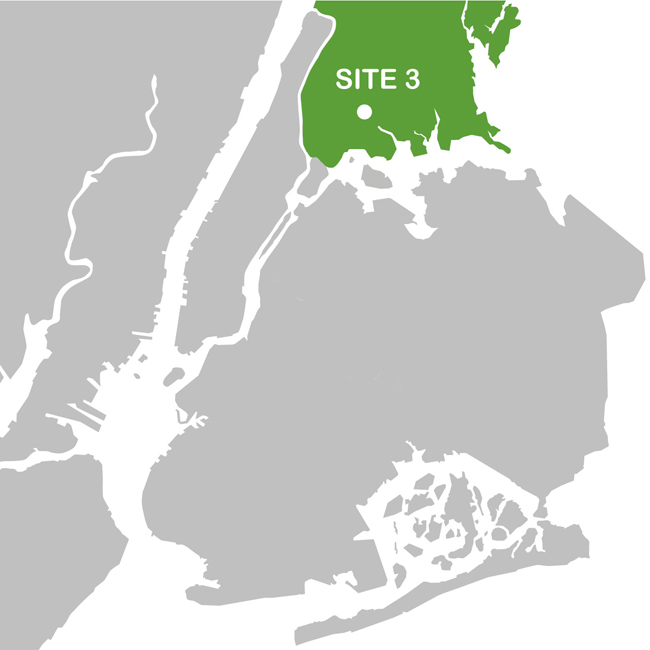
SITE 3
1731 Montgomery Avenue
Morris Heights, The Bronx
Site 3 was in the Morris Heights area of the west Bronx. The neighborhood was a mixture of high-density multifamily buildings and freestanding one- and two-family dwellings. Site 3 measured 50′ x 100′ and was zoned R5. The Morris Heights area lost a large segment of its population between 1970 and 1976, but by the 1980s had begun to gain residents again. In 1987, over 50% of the population in Community District 5 was under the age of 25. In 1985, about 15% of the land in the district was vacant.
The proposal by Jin Kim for Site 3 looks to the needs of single-parent families — from social interaction and community involvement, to child care and accessible work spaces, to the need for privacy and independence — while also acknowledging the social benefits of cross-generational interaction and shared spaces. Jin Kim’s original project statement, as published in the 1989 book documenting the Vacant Lots study, follows:
Jin Kim
One third of American families are headed by single parents who are at or below poverty level. Not only do they need housing which they can afford, but that housing should provide privacy and improve their life style, allowing both for their independence and their assimilation into the community.
This housing is designed to translate these needs into a physical entity. Isolated parking provides more usable space for communal activity. The basement offers a workshop for single parents and a day care center for residents and the community.
Because of the multiplicity of ages and life styles provided for in the project, various single people may serve as role models for children and enhance socializing. The entrance, stairs and laundry are designed to bring residents together in the common areas.
Construction Classification: 11-B
Occupancy Group: J-2
Type Of Construction: Brick faced concrete block bearing wall with protected wood joist. Gypsumboard ceiling, metal stud interior partitions with painted gypsum board. Wood strip flooring on plywood subfloors.
Mechanical System: Individual cooling/heating air handling unit (gas fired furnace) and hot water heater for each apartment.
Today, the site has been developed into duplex apartments and a detached one-family townhouse. From 1985 to 2010, vacant land in Community District 5 dropped from about 15% to only 3.4%, while the population of the district under the age of 25 remains higher than the rest of the city at 42.5%.
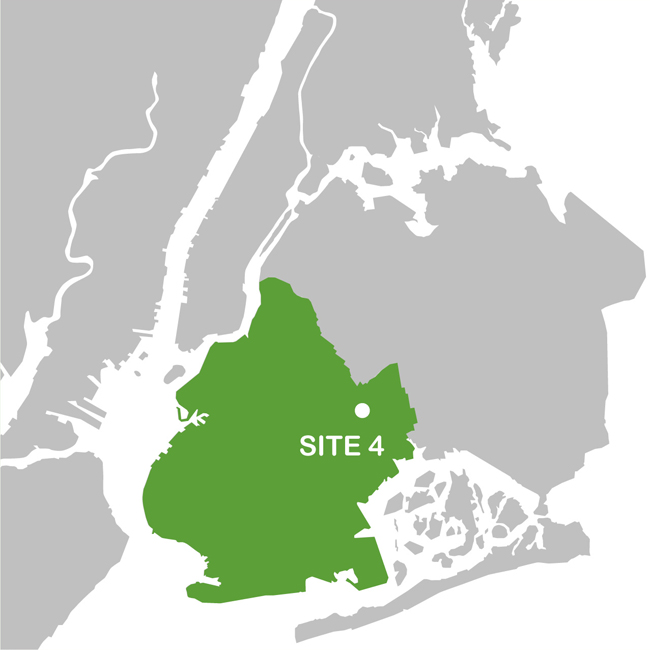 SITE 4
SITE 4
444 & 474 Miller Avenue
East New York, Brooklyn
Site 4 was made up of two separate parcels on Miller Avenue in the Ocean Hill-Brownsville section of Brooklyn, in Community District 16. Each of the parcels measured 20′ x 100’. One was zoned R6, the other R6, C1-3. In 1987, Ocean Hill-Brownsville had a mixed housing stock that included a large number of government-aided housing projects, built under many different programs and including a variety of architectural types, from high-rise to low-rise. The area lost almost 40% of its population between the 1970 and 1980 censuses, but by the late 1980s had stabilized or even begun to grow. In 1985, about 24% of the land in the district was classified as vacant.
Site 4 posed the challenge of how to use two separate, narrow parcels of land within one city block. Rather than see the small lot size as a restriction, Karen Fairbanks and Jonathan Jaffe chose to focus on their potential as access points to an otherwise underutilized interior yard. By activating these ground floor spaces with public amenities, the team aimed to create a strong connection to the surrounding community. Karen Fairbanks and Jonathan Jaffe’s original project statement, as published in the 1989 book documenting the Vacant Lots study, follows:
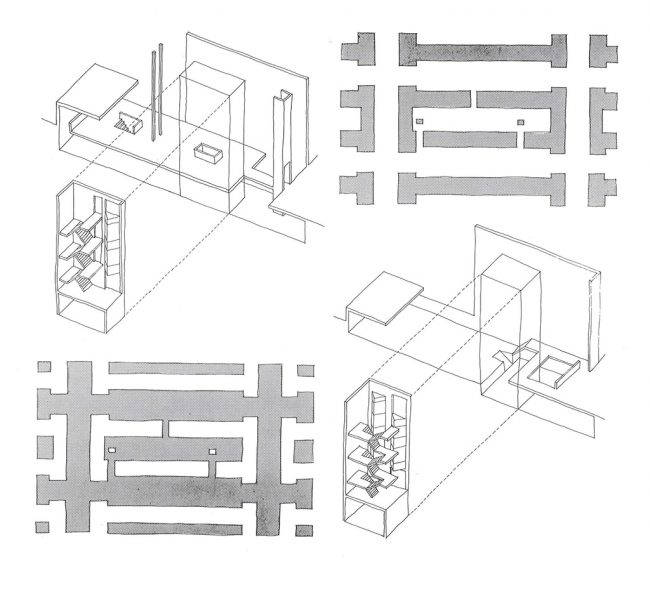
444 & 474 Miller Avenue, Brooklyn | Vacant Lots design study response by Karen Fairbanks and Jonathan Jaffe
Karen Fairbanks and Jonathan Jaffe
We see these lots as gateways, functioning as a communal link by providing public amenities (i.e., social rehabilitation, counseling, day care, community centers, nutrition and health care, or possibly even vocational training tied to commercial activity) directed by city officials and perhaps providing employment for residents. Thus, all ground floor and basement level activities are public, allowing a direct connection from the street wall to the inner block.
Vacant lots of this character have the natural potential to bring life into the typical New York phenomenon of the isolated inner block by providing a link, both physically and programmatically, to the existing urban structure. Taking advantage of the specific site conditions (i.e., two vacant lots within one block), we inserted two pavilion/work places into the inner block to generate activity along its length and to physically mark our urban insertions.
Following our urban attitude is the residential circulation space, which provides an open connection through a publicly observed entry sequence to a privately observed vertical sequence. Our intention was to activate the private circulation tower of the residents by inserting a projection from each unit into this public room. The roof terrace is the natural culmination of this sequence. We believe that by creating this space we not only improve security but generate a communal structure.
We find that the importance of this study (on these two very narrow sites) remains in its urban potential rather than in the development of a specific construction system. Yet, keeping in mind the need for an economic construction method, the units were designed on a rigid grid that can be easily translated into one of many prefabricated panel systems, both for inner partitions and exterior walls.
At 444 Miller Avenue, construction of a new residence began in the mid-2000s, but the project remains incomplete. Since 2006, neighbors have been filing complaints, initially about construction but later about the condition of the abandoned site. At 474 Miller Avenue a new duplex has been constructed. From 1985 to 2011, vacant land in Community District 16 dropped from 24% to 5.7%. Since losing so many residents in the 1970s, the population of the district has stabilized, growing 1.3% from 2000 to 2010.
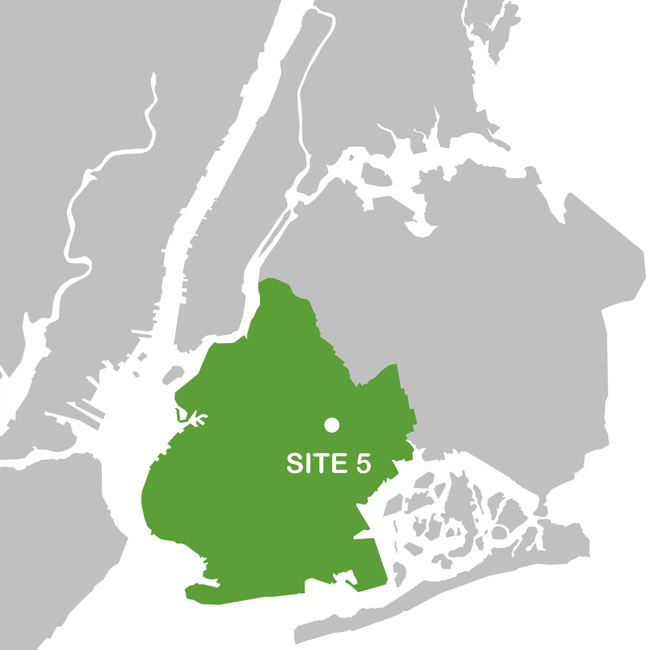 SITE 5
SITE 5
435, 437, 439, and 443 Amboy Street
Brownsville, Brooklyn
Site 5 was in Ocean Hill-Brownsville, in Brooklyn Community District 16. The site consisted of four adjacent lots, with an overall size of 80′ x 100′ and was zoned R6. Nearby are a number of blocks of the Nehemiah Homes built by East Brooklyn Churches.
In their proposal for Site 5, Deborah Gans, Brian McGrath and Mark Robbins paid careful attention to housing precedents in and the particular demographics of the Brownsville neighborhood. Their flexible design provided options for extended or otherwise non-nuclear families, utilized economical construction methods, and offered a balance between privacy and shared space. Gans, McGrath and Robbins’ original project statement, as published in the 1989 book documenting the Vacant Lots study, follows:
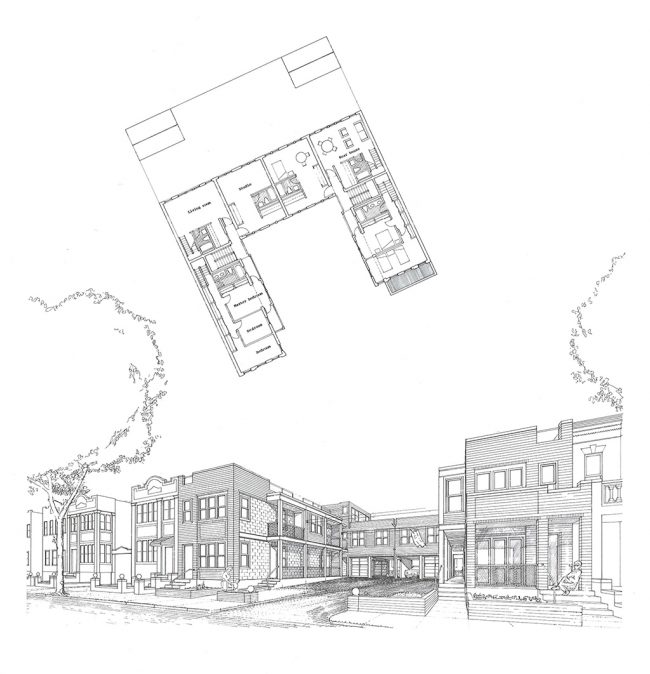
435, 437, 439, 443 Amboy Street, Brooklyn | Vacant Lots design study response by Deborah Gans, Brian McGrath and Mark Robbins
Deborah Gans, Brian McGrath, Mark Robbins
The Brownsville district surrounding Site 5 is an area with an expanding population of “government-aided, low- and middle-income families, primarily consisting of female heads of households.” (“Statement of Community District Needs for Fiscal Year 1988,” Community Board No. 16, The City of New York.) Many of these families include daughters who are themselves single mothers. Site 5 is located on a typical district block of one- to three-family, paired rowhouses with side yards which serve as driveways. Two provocative recent projects conceived for large sites stand nearby: the Marcus Garvey apartments, which are organized around courts and mews, and the Nehemiah complex of single-family attached homes. We have kept the format of the paired rowhouse but expanded the side yard into a viable communal space reminiscent of the Marcus Garvey courts. From Nehemiah we have adopted economical construction materials and methods.
We have developed a program that allows the extended family member (i.e., the single mother, grandparent or immigrant cousin) to live in close proximity to the family.
In order to provide a flexible structure with options for dependence and distance, we have assembled several dwelling types around a shared court. The front duplex rowhouses can be internally connected to rear studio garden apartments. Above the apartments and facing the court are duplex rear houses. These duplexes are adjacent to studio apartments above the garage. Depending on excavation costs, basement flats could be added. All off-street dwellings and the garden are reached by side porches.
The court brings light and air to the side of the building, which in the traditional rowhouse is blocked. Both court and garden provide space for recreation under family supervision. Finally, as a local urban space, the court enhances neighborhood street life.
New three-story residences were built on Site 5 in 1990.
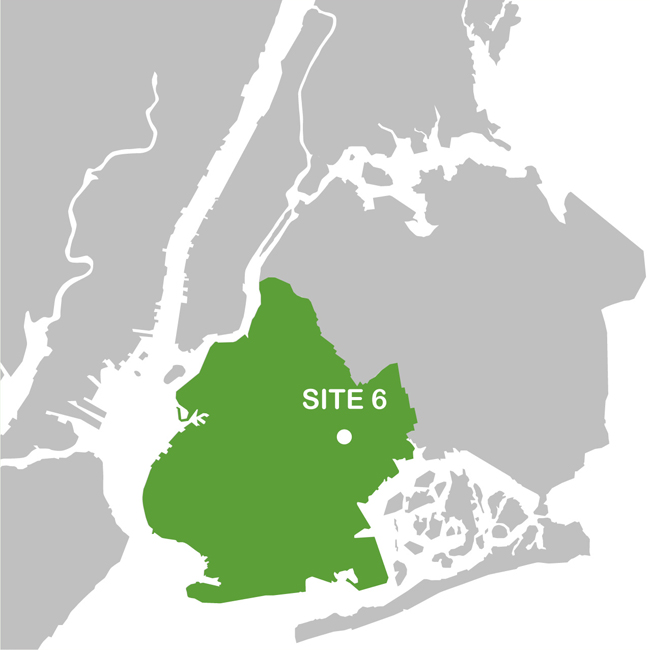 SITE 6
SITE 6
508 Thatford Avenue
Brownsville, Brooklyn
Site 6, in Community District 16, measured 22′ x 100′ and was zoned R6. In 1987, this area of Brooklyn abounded with lots like 508 Thatford. The community board wrote in its “Statement of Community District Needs for Fiscal Year 1988” that there were “tracts of vacant land … throughout our district. These areas tend to be unattractive to developers who more often than not are looking for blocks of vacant land for larger type developments. Our need, however, is for multiple, low-rise apartments to attract middle-income residents who may not wish to purchase a house.”
For Site 6, the team from Blumenfeld and Krone Architects confronted challenges of adhering to zoning and building code requirements while staying consistent with the neighborhood context. Through a creative approach to circulation and light, the team worked to improve access and openness without sacrificing the interior space of the building itself. Blumenfeld and Krone’s original project statement, as published in the 1989 book documenting the Vacant Lots study, follows:
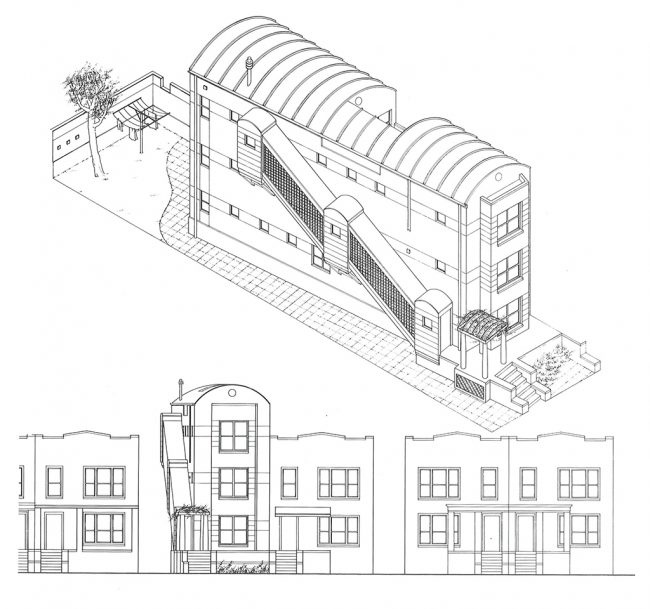
435, 437, 439, 443 Amboy Street, Brooklyn | Vacant Lots design study response by Blumenfeld and Krone Architects
Blumenfeld and Krone Architects
The buildings which surround this lot are illegal under today’s zoning and building code regulations on a number of counts. Hence this site is a difficult one, because if we were to repeat the present building type, we would produce units with habitable rooms facing a three-story, six foot light well and railroad plans. By inverting the type, placing the circulation on the outside and creating a court for light and air on the inside, we have attempted to avoid these problems. The court is smaller than the code requires, but it is only closed on four sides for one (the second) story. The first floor bedroom beneath has an operable skylight.
We have used a straight run of circulation for two reasons: it eliminates a layer of circulation necessary for doubling back, and once there is headroom at grade, circulation to units and access to backyard could be overlapped by angling the building. The building at the rear can span almost the entire site, except for a portion of the width of the stair, while access is still possible to the backyard at grade level.
Until 2002, Site 6 remained vacant and was used to park cars illegally. It was bought in 2005 and a new three-family dwelling was built. Although the percentage of vacant land in Community District 16 has dropped from 24% in 1985 to 5.7% in 2011, just south on Thatford Avenue lies another vacant lot containing several inoperable cars.
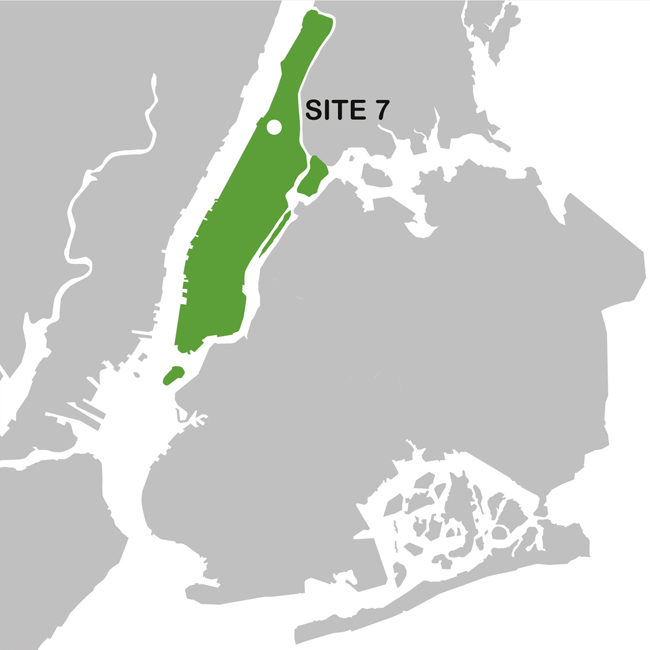 SITE 7
SITE 7
511 West 133rd Street
Harlem, Manhattan
Site 7 was 50′ x 100′ and was zoned R7-2. The site faced a large public housing project; just east, across Amsterdam Avenue, was City College. At the time, more than 60% of the land area in this Community District 9, which stretched from 110th to 155th Streets, was devoted to multifamily buildings. In 1985, 5% of the land in district was vacant.
Site 7, in the middle of West Harlem across the street from the Manhattanville Houses, presented one of the densest contexts of the ten Vacant Lots sites. The team from Tod Williams, Billie Tsien and Associates used that setting as an opportunity to contemplate the difference between openness and emptiness, and to explore strategies for “reintegrat[ing] the superblock into the city fabric.” Tod Williams and Billie Tsien’s original project statement, as published in the 1989 book documenting the Vacant Lots study, follows:
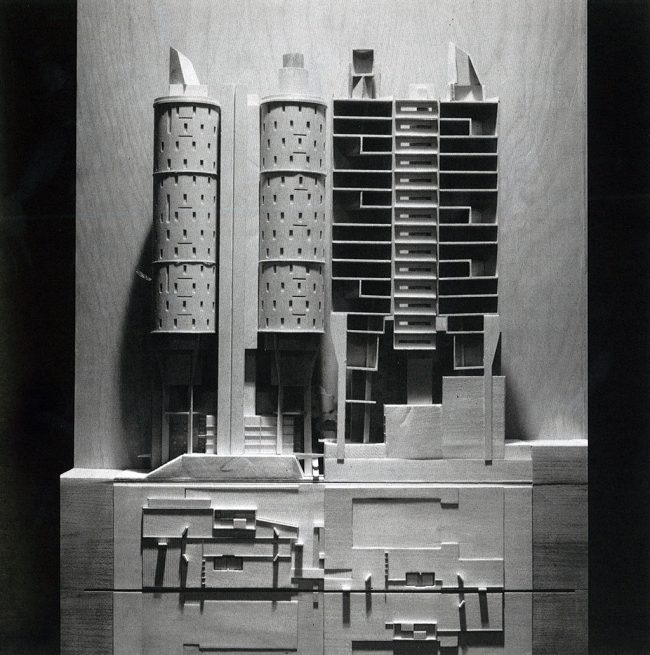
511 West 133rd Street, Brooklyn | Vacant Lots design study response by Tod Williams, Billie Tsien and Associates
Tod Williams, Billie Tsien and Associates
Project team: Tod Williams, Billie Tsien, Rick Gooding, Annie Chu, Marwan Al-Sayed, Tom Van Den Bout, Thomas Gardner Assistance: Alice Weatherford, Steven Iino, Lee Miller, Ron Driller, Raveevarn Choksombatchai
This proposal accepts the open lot as a positive addition/subtraction to the dense Manhattan city block. It recognizes the importance of openings to the interior of the typical block to bring additional light and air, to re-establish the relationship of court to street, and to expose the natural topographic features of the interior. It does not, however, accept the vacancy of the open space, suggesting instead that this exceptional condition implies a responsibility. It must retain its openness, but it must not be empty; the open lot must be inhabited.
This proposal enhances and criticizes the New York City block. The city block of the 19th century, one of the great urban yardsticks, is not always the ideal condition. The two suggested north/south breaks or interventions into the block are intended to supply alternate scale and means of movement. The double cylindrical tower often marks this path and, when coordinated with existing structures, can vitalize alternate pathways between places of significance, such as the subway and the school.
The proposal recognizes the value of Le Corbusier’s vision in which dwellings have been made into great hotels, “vessels floating in a sea of green.” Although the Manhattanville project of 1960 (directly to the south) provides vast views and retains a certain percentage of ground for green space, the “Y” shaped slabs are too large: they obstruct each other and the views of the adjacent community, and they create enormous shadows. The economically built floors are anonymous, too large for social interaction between neighbors and providing few physical or social amenities. The Manhattanville project-like so many other projects of this period-aims at density and improved light and air, but also represents a full scale attack on Manhattan’s past by eliminating the structure of the block and Old Broadway.
In response to Manhattanville, our proposal calls for reasserting the block structure through the creation of a one to two story base of commercial and community activity. The roofs of these low buildings would be planted with private gardens for Manhattanville residents. Certain block-through paths running north and south, would remain at grade for public use. It is important to break down and reintegrate the superblock into the city fabric.
THE SPECIFIC PROPOSAL These towers, 35 feet in diameter, cast narrow shadows across the block. They are not walk-ups, though stairways are used to communicate between several floors. The floor plans take their cues from lofts, which have the advantage of providing for both flexible and traditional life styles. Communal accommodations, the laundry room, and children’s play areas occur below the tower in private indoor and outdoor space; commercial activity fronts the street itself. Openness of the plan at the lower levels encourages participation in the “natural” interior of the New York City block. For the apartments, open space with minimal plumbing and kitchen facilities is the starting point. Incentives would encourage individuals to create their own plans (including enlarged bathrooms and kitchens) but this would be the responsibility of each tenant. Otherwise, more traditional apartment layouts are indicated. Within each cylinder, double-height spaces are proposed for additional floor area as well as for the feeling of increased space.
Since the exterior of each cylinder is structural, windows are both numerous and small. A consistent window pattern is overlaid with additional openings that are view- and site-related. Although the general structural conditions of the cylinders are identical throughout, the particulars of facade, form, and activity at street level would be determined case by case.
At 133rd Street, a broad stairway is used to enter the once vacant lot. Beneath the protective canopy of the structure, neighbors from the towers may gather and passers-by cross through to 134th Street. In this experience, topographic change is celebrated and the existing rubble stone retaining wall is revealed as an integral part of the street-level garden. The lot is open but no longer empty. It has become a positive subtraction. It is from here, a quiet protected space, that the residents ascend to private apartments and to privileged views of the cityscape of New York and beyond.
“A great city is nothing more than a portrait of itself, and yet… its arsenals of scenes and images are part of a deeply moving plan. As a book in which to read this plan, New York is unsurpassed. For the whole world has poured its heart into the city by the Palisades, and made it far better than it had any right to be.” Mark Helprin, Winter’s Tale
In 1993, Site 7 was acquired using eminent domain by the City in partnership with the New York State Housing Finance Agency for the Amsterdam Avenue/West 133rd Street Permanent Housing for Homeless Families Land Use Improvement Project. In 1998, the New York State Division of Housing and Community Renewal and the Harlem Restoration Project agreed to maintain the property as low-income housing. Only 3% of the land in Community District 9 remains vacant.
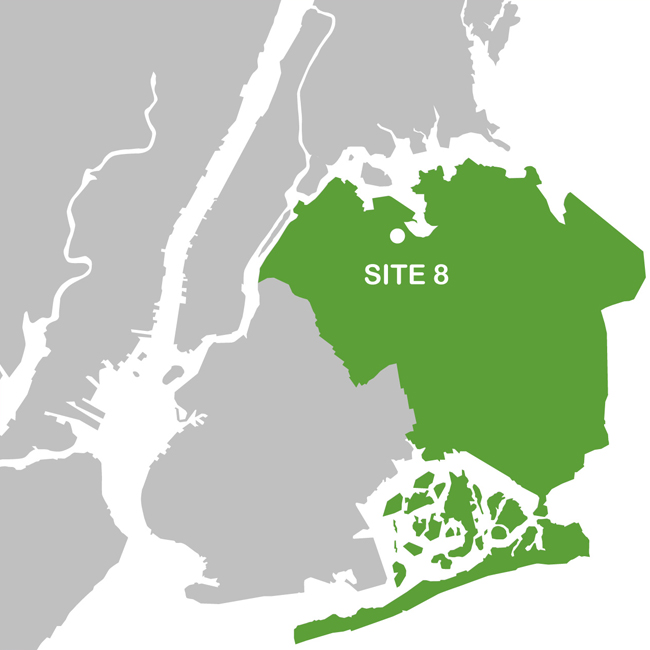 SITE 8
SITE 8
3215 106th Street, 3214 107th Street
Corona, Queens
Site 8 was a through-block site, 40′ x 195′, in Corona, Queens. It was zoned R5. Almost 70% of the land in Community District 3 was devoted to one- and two-family houses, including a large number of wood-frame houses. The area had a relatively low percentage of the population (12%) receiving public assistance. In 1985, 4.5% of land in the district was classified as vacant.
Anthony Tsirantonakis, in his proposal for Site 8 in Corona, Queens, acknowledged the spatial needs of the many multi-generational, and often immigrant, families in the surrounding neighborhood. In what he calls the “Grandmother/Mother/Daughter House,” he conceived of a series of spaces that allow proximity as well as privacy, and flexibility to allow for change over time. Anthony Tsirantonakis’ original project statement, as published in the 1989 book documenting the Vacant Lots study, follows:
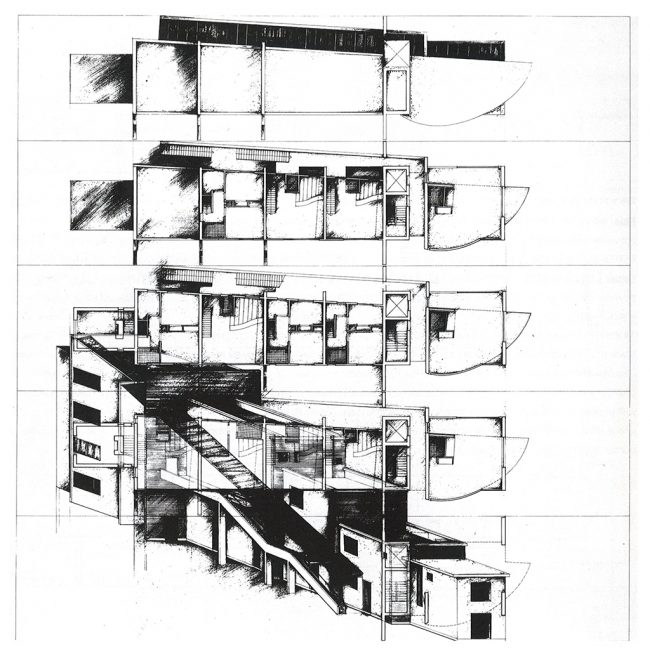
3215 106th Street & 3214 107th Street (Right) | Vacant Lots design study response by Anthony Tsirantonakis
Anthony Tsirantonakis, RA, of Nine Square Design
Queens is a borough of many neighborhoods comprised of small attached and semi-attached brick houses with small front yards and stoops, occupied by families, many of whom are immigrants or migrants from other parts of the United States. These small brick houses become the physical center for the family, the new hearth accommodating all the generations, allowing closeness and warmth but little distance or privacy.
This site, though large enough to house a box-like container with tray-like apartments, would be ill-served by such a design. I felt the small brick house was a sympathetic type to the fabric of the city and should be promoted, so instead of the box, I have designed a structure inspired by the small brick house. The Grandmother/Mother/Daughter House is comprised of small house and tower elements formed to allow not only proximity between generations but also mobility and privacy.
This proposal is a sociological and emotional statement, but it is also meant to be built and occupied. In the family tree, the parents, being the most financially liquid, would own the “mother’s” duplex apartments. Four of the owners of these duplex apartments would also own a studio apartment in the “daughter’s” tower, for rental, ideally, to another family member. This allows flexibility in movement between the “house” and the apartment as family arrangements change. The grandmother’s house is a gathering place for the entire complex and is subsidized by the other owners.
The site, being between the corner and the mid-block, allows a building with facades oriented toward the side street and demising walls oriented towards the corner lots. It also allows a backyard building which has its own mystique.
In 1989, Site 8 was one of 22 City-owned properties developed into one- or two-family homes as part of the NYC Partnership New Homes Program. Two homes were constructed, one facing either street on the through lot. The home pictured in the 1987 photo, adjacent to Site 8, was destroyed in a fire in the years following the Vacant Lot study. Site 8, since developed, now lies adjacent to a vacant lot itself.
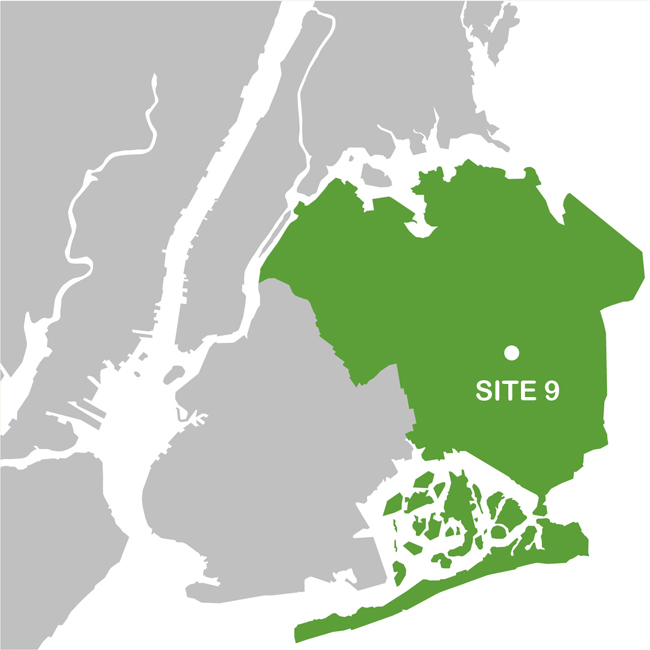 SITE 9
SITE 9
10911, 10913, and 10915 164th Street
Jamaica, Queens
Site 9, three adjoining lots, was 66′ x 100′, with R4 zoning. The neighborhood, in Community District 12, was a very low-density area of wood-frame houses. Overall, one- and two-family houses took up 83% of the land area in the district. Vacant land accounted for 8% of the area. The community board wrote, “In this district a serious problem exists with illegal land use. It seem that almost every vacant lot becomes a junkyard, and the sad thing is that they are never closed.”
As Deborah Gans discusses in her Vacant Lots catalogue essay “City of Imagination,” the design responses to each of the ten sites range in their adherence to or divergence from local context. Marc Litalien and Noah Carter, in their proposal for Site 9, present an example of what Gans calls “an extreme attitude of contextualism.” By reinterpreting the wood-frame, one- and two-family houses so common to the area to allow for more density, they defer to the neighborhood’s apparent preferences and identity while also increasing the available housing stock. Litalien and Carter’s original project statement, as published in the 1989 book documenting the Vacant Lots study, follows:
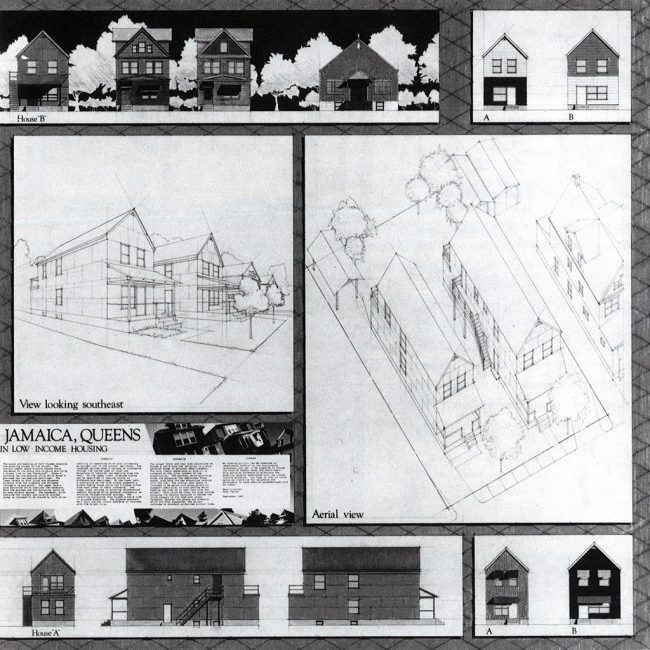
10911, 10913, 10915 164th Street, Queens | Vacant Lots design study response by Marc Litalien and Noah Carter
Marc Litalien and Noah Carter
Site 9 has been developed into a four-family residence. Community District 12 maintains its low-density character with one- and two-family housings still making up the majority of housing. By 2011, vacant land in the district had dropped from 8% of the area to 2.5%.
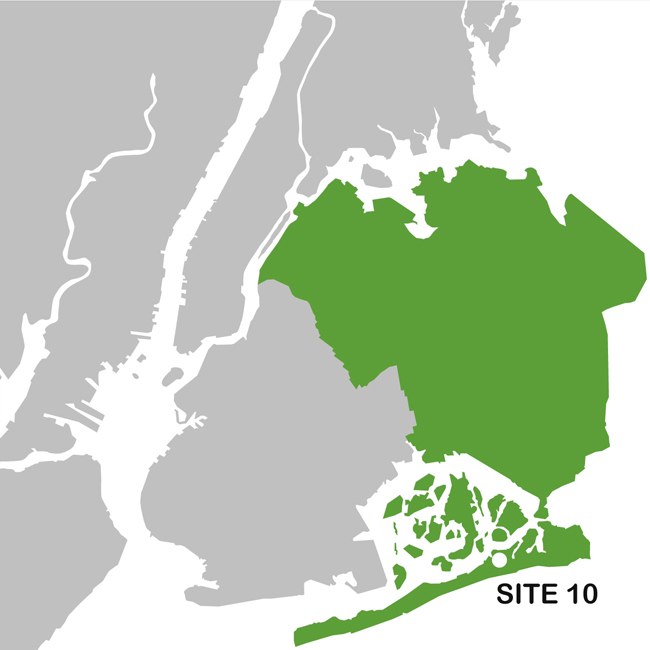 SITE 10
SITE 10
6948, 6950, 6956, and 6958 Almeda Avenue
Arverne, The Rockaways, Queens
Site 10 consisted of two parcels, each 40′ x 100′, on the Rockaway Peninsula in Community District 14. The predominant housing type in the immediate neighborhood was the three-story duplex; the district overall included every type of housing, from high-rise housing projects to single-family homes. At the time, 15% of the land in the district was vacant. Much of the Peninsula is vulnerable to flooding.
One approach to reducing the cost of housing is to employ efficient construction methods and inexpensive materials. In their proposal for the two parcels of vacant land on Site 10, the team from McDonough Nouri & Associates proposed the use of simple, durable materials; prefabricated elements and tilt-up construction; and energy efficient interventions to maximize design quality while keeping expenses low. McDonough and Nouri’s original project statement, as published in the 1989 book documenting the Vacant Lots study, follows:
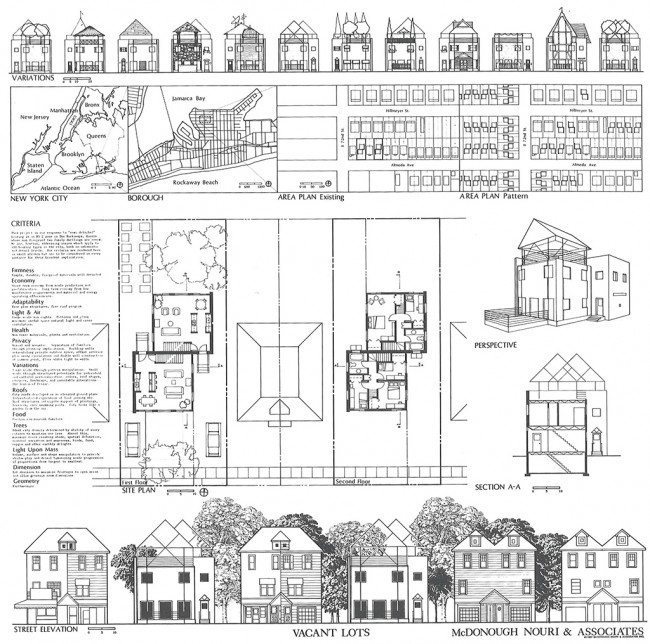
6948, 6950, 6956, 6958 Almeda Avenue, Queens | Vacant Lots design study response by McDonough Nouri & Associates
McDonough Nouri & Associates
William A. McDonough, partner-in-charge; Hamid R. Nouri, managing partner
Janet S. Roseff, Steve Pynes, Judy O’Buck Gordon, Joe Vance, Carl Finer
Existing buildings in this district evidence their owners’ interest in expressing their individuality. This creates a schism between the intention of the originally unified facades as they are rendered superficially distinct along the vertical property line.
Also, this centrally split personality only allows a dwelling width of approximately 13 feet x 6 feet, a driveway in which the car must dominate outdoor space at the rear yard.
Our proposed scheme forms distinct individual facades, and gives each a dimension of 22 feet fronting a wide garden. The property is equally divided along an offset line. This allows for a large and small scale variety in residential open space and does not place long building sides cheek to jowl along dark alleys.
Criteria This project is our response to “semi-detached” housing in an R3-2 zone in The Rockaways, Queens, where non-fireproof two-family dwellings are zoned. We are, however, addressing issues which apply to all housing types in the city, both on urbanistic and detail levels. Our criteria are rendered here in small strokes but are to be considered in every instance for their broadest implications.
Firmness Simple, durable, fireproof materials will be well detailed.
Economy Short-term economy from scale production and prefabrication. Long-term economy from low maintenance requirements and material and energy efficiencies.
Adaptability Free plan structures, free roof program.
Light & Air Large-scale sun rights. Patterns and plans maximize useful space, natural light, and cross-ventilation.
Health Non-toxic materials, plants, and ventilation.
Privacy, visual and acoustic Separation of families through planning implications. Building walls articulating private outdoor space, offset interior plan using circulation and double wall construction at common joint, floor slabs tight to walls.
Variations Large scale through pattern manipulation. Small scale through structured potentials for individual and cultural personalization: colors, roof shapes, canopies, landscape, and inevitable alterations — the lesson of Pessac.
Roofs City roofs developed as an elevated ground plane. Individualized expression of land joining sky. Roof structures anticipate support of plantings, terraces, even swimming pools. City looks like a garden from the air.
Food Gardens can nourish families.
Trees Ideal city density determined by ability of every citizen to maintain one tree. Absent this, maximize trees creating shade, spatial definition, seasonal variation and awareness, birds, food, oxygen and other earthly delights.
Light Upon Mass Volume, surface, and shape manipulation to provide shadow play and detail, humanizing scale progression of proportions from largest to smallest.
Dimension Lot division to maximize frontages to open areas and allow generous room dimensions.
Geometry Earthmeasure.
In the early 2000s, a three-story duplex was built on Site 10. At the time of the study, the initial site description included that “much of the peninsula is vulnerable to flooding.” In October, Hurricane Sandy caused extensive flooding and heavy damage to the entire neighborhood. In 2011, 11.5% of the land in Community District 14 was vacant, a number that will most likely rise as a result of damage from the storm.
In 1987, the League collaborated with the New York City Department of Housing Preservation and Development (HPD) to launch a design study examining the potential of small-scale infill housing to contribute to the city’s affordable housing portfolio. “Vacant Lots: Then and Now” is part two of a three-part Architectural League feature that recalls the Vacant Lots study and explores the persistent challenges of creating safe and quality affordable housing in New York City.
The views expressed here are those of the authors only and do not reflect the position of The Architectural League of New York.